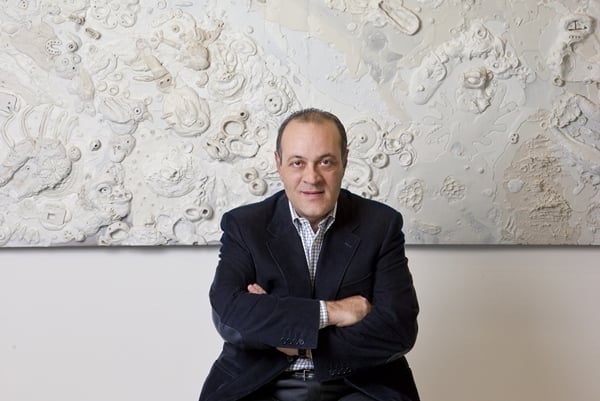
Photo: Trevor Leighton, courtesy ICI.
Greek financier and collector Dimitris Daskalopoulos recounts his first thought upon seeing how a curator arranged works from his collection for the first of a four-part series at the Whitechapel Gallery in London in 2010: “I asked permission to sleep in the Whitechapel room the first I saw the installation. I just wanted to stay there forever. It was beautiful.”
Daskalopoulos, who is based in Athens, notes that he hardly lives with any of the nearly 500 works he has amassed in more than two decades of collecting. “Most of the collection is large installations and sculpture. I’d have to move out to put even a couple of them in my home.”
In addition to overseeing the D. Daskalopoulos Collection, last year he founded NEON, a non-profit contemporary art organization. He is a trustee of the Guggenheim Foundation as well as chairman of its collections council, a member of the Tate International Council and the New Museum’s leadership council. His collection has been the basis for exhibitions at the Guggenheim, Bilbao, the Whitechapel, and the Scottish National Gallery of Modern Art.
We caught up with Daskalopoulos who is in town to accept the Leo Award (see “Dimitris Daskalopoulos Gets ICI’s 2014 Leo Award”) tonight from the Independent Curators International (ICI) at a ceremony and annual benefit auction in downtown Manhattan. Named after legendary dealer Leo Castelli, the Leo Award is given every two years to an influential art world figure, be it a collector, dealer, artist, or patron.
“It was a very gratifying surprise,” Daskalopoulos told artnet News about being selected for the award. “I live in southern Europe and here’s somebody from America noticing what we’re doing there and deciding its worthy of an award.”
Among other successful projects and initiatives he’s spearheaded, this past September under the auspices of NEON, he brought Tino Sehgal’s performance piece This Progress (which had a successful run at the Guggenheim New York in 2010) to central Athens, where it was performed in the ruins of the Roman Agora, an open space just north of the Acropolis. The piece involves “peripatetic philosophers” engaging people in dialogue, asking questions like: “How do you keep ancient Greek civilization alive in the 21st-century?”
Noting that it was the first time the work had been presented in an open area, Daskalopoulos says “It was such a relevant space because this work asks the question ‘What is progress?’ and has this discussion with four people from different age groups. So it’s the peripatetic philosophy that was developed in Greece two and a half thousand years ago, that’s happening today.” He says the work, which involved 140 people that were trained by “Tino and his team,” struck a chord with tourists and locals alike. “People revisited this whole idea that we are proud of in Greece, that we invented democracy and that was very active in the ancient agoras, which was the meeting place for discussion and debates. People just went back to the reality of this history and its importance and the great experience of the performance. It was a revelatory experience for both the actors and the public.”
In other words, it is exactly the type of project NEON was created for. Noting that the foundation has no building, Daskalopoulos says “the goal is to go to where people might be interested in coming into contact with contemporary art and its ideas. I this is also very important for Greece because the crisis we went through was basically cultural. It was an economic crisis but at the base, it’s cultural. I think through the exposure to contemporary art, we can help the minds of people become more confident, more creative, more innovative, more risk-taking. I think that’s what we need in the long term in Greece to avoid another crisis.”
Daskalopoulos said that even from his early days of collecting, “what has been the pillar of my collecting is a certain very coherent way of thinking and feeling that has been very steady over the years. I was always interested in the human condition and the human struggle…this marvelous ability to remain optimistic and positive despite difficulties. I’m always looking for artworks that express this struggle, this creativity, this marvel.”
To his mind, the artists who represent this theme well, and who are heavily represented in his collection, included Louise Bourgeois, Robert Gober (two of Daskalopoulos’s works are on loan to the current MoMA show), and Kiki Smith. “I also look at the unbridled, limitless creativity like you see in Matthew Barney and John Bock,” he says.
Asked what the next major project the busy collector will embark on, Daskalopoulos says, “we have our hands full right now with NEON and its activities.” He adds “when I did a major merger seven or eight years ago in my company and doubled its size, I took a piece of paper and I wrote ‘THE NEXT BIG ONE’ and put it next to my chair. It should have been the end, but I’m always thinking of the next big one.”